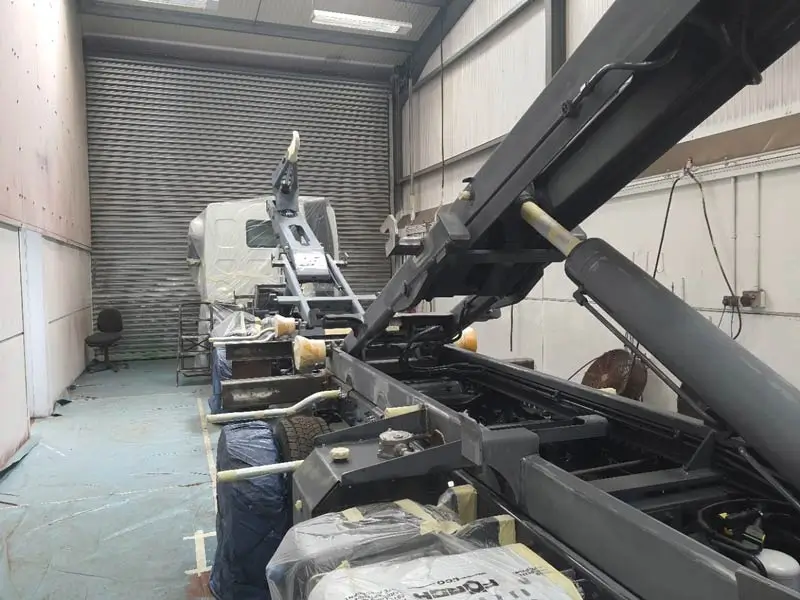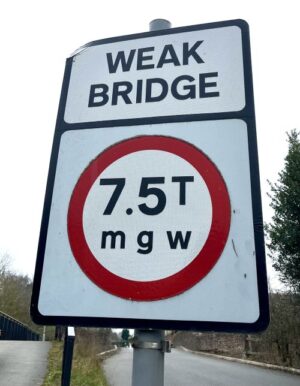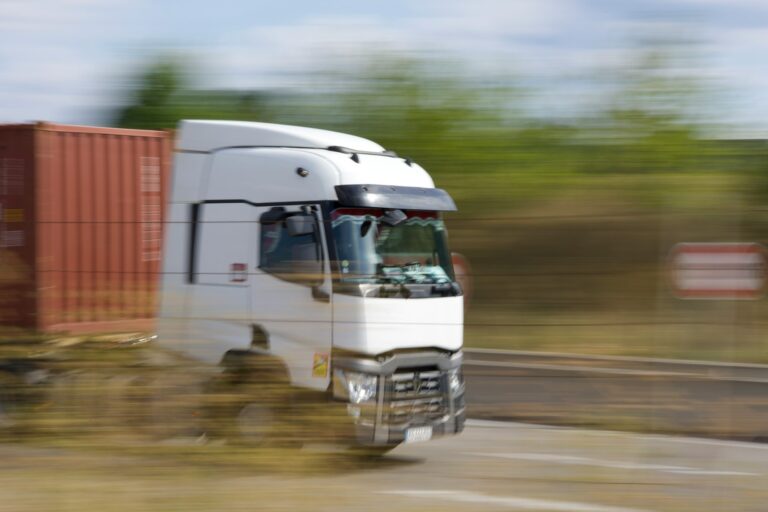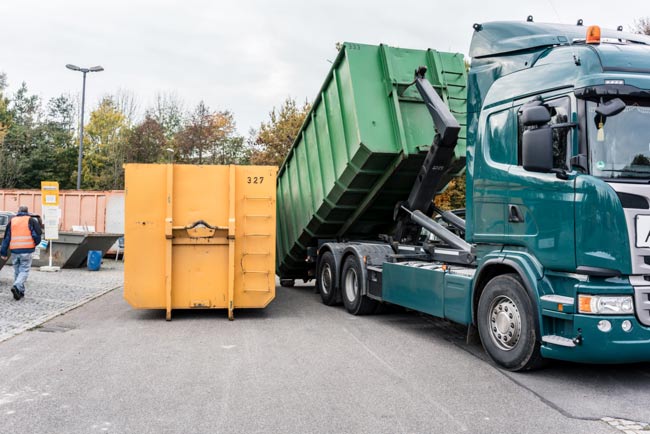Hook loaders are a familiar sight across the UK waste and recycling sector, but for many outside the industry the term is less obvious. Even seasoned operators sometimes use the equipment daily without stepping back to consider how versatile and central it has become to modern waste logistics.
This guide explains what a hook loader is, how it works, and where it’s used. We’ll also cover compliance considerations, cost factors, and practical examples that matter to operators, fleet managers, and skip hire companies.
What Is a Hook Loader? (Definition)
A hook loader is a type of heavy goods vehicle (HGV) designed to lift and transport large containers, skips, or bodies using a hydraulic hook arm.
- The hook arm extends and locks onto a specially designed lifting bar on the container.
- Hydraulics then pull the container onto the vehicle’s chassis.
- Once secured, the load can be transported to site and offloaded by reversing the process.
Because the container can be detached, a hook loader is more flexible than a fixed-body tipper. Operators can swap different bodies on a single chassis, reducing downtime and maximising fleet efficiency.
View our stock: Hook Loaders sales
How Does a Hook Loader Work?
Hook loaders rely on a hydraulic lifting arm mounted behind the cab:
- Positioning – The driver aligns the HGV with the container.
- Engagement – The hook connects to the container’s lifting bar.
- Loading – The hydraulic arm pulls the container onto the chassis.
- Securing – Mechanical locks ensure the load is safe for transport.
- Unloading – The process reverses, allowing the body to be tipped or set down.
This system is designed for speed and repeatability. A trained operator can load or unload in minutes, minimising site disruption.
Common Hook Loader Uses
Hook loaders are widely used across waste, construction, and demolition sectors. Typical applications include:
- Skip hire operations – Moving roll-on/roll-off skips between customers and transfer stations.
- Recycling centres – Transporting containers of sorted materials (metal, wood, plastics).
- Demolition projects – Handling heavy debris in interchangeable bodies.
- Green waste collection – Seasonal jobs where quick turnaround is key.
- Construction sites – Delivering aggregates, then removing waste in the same vehicle.
Example: A skip hire operator with five hook loader chassis can keep ten or more containers working at once. Containers can be left with customers while the vehicles continue servicing other sites.
Advantages of Hook Loaders
For waste operators and fleet managers, the benefits of hook loaders are practical and measurable:
- Flexibility – One vehicle, multiple bodies (skips, flatbeds, tankers).
- Efficiency – Reduced turnaround time at customer sites.
- Lower downtime – Vehicles keep moving while containers remain on-site.
- Safety – Controlled hydraulic systems minimise manual handling.
- Cost savings – Fewer chassis needed compared with fixed-body fleets.
| Benefit | Why It Matters for Operators |
|---|---|
| Versatility | Handle multiple waste streams with one vehicle. |
| Fleet optimisation | Reduce need for spare vehicles. |
| Site productivity | Faster load/unload keeps projects moving. |
| Compliance & safety | Meets modern waste handling regulations. |
Hook Loaders and Compliance
Running hook loaders comes with regulatory responsibilities. Fleet managers should ensure:
- Operator’s Licence – Vehicles over 3.5 tonnes require the correct licence.
- Driver CPC training – Operators must be qualified and up to date.
- Load security – Containers must be locked and checked before transport.
- Weight limits – Overloading can lead to fines and downtime.
- Maintenance checks – Hydraulic arms and locks require scheduled inspection.
Have a read through more lorry types in our article here: Types of Lorry)
Hook Loader vs Skip Loader vs Tipper
Many operators compare these vehicle types when planning fleets:
| Vehicle Type | Best For | Key Limitation |
|---|---|---|
| Hook Loader | Large containers, flexible waste streams | Needs trained driver and space to manoeuvre |
| Skip Loader | Smaller domestic and commercial skips | Limited to skips only |
| Tipper | Bulk materials, demolition rubble | Fixed body reduces flexibility |
Most medium-sized skip hire companies will operate both hook loaders and skip loaders, using each where it’s most efficient.
Practical Buying & Hiring Considerations
When choosing a hook loader, consider:
- Chassis size – Commonly 18t, 26t, or 32t depending on container size.
- Hydraulic system – Strength and speed of operation.
- Container compatibility – Ensure lifting bar and dimensions match fleet.
- Maintenance history – For used vehicles, check hydraulic wear.
- Hire vs purchase – Hiring can reduce upfront costs for seasonal spikes.
Looking to hire? Check our prices and stock levels here: Hook Loaders for Hire
FAQs About Hook Loaders
What is a hook loader and how does it work?
A hook loader is an HGV fitted with a hydraulic hook arm that connects to a container’s lifting bar. The arm pulls the container onto the chassis for transport, then offloads it by reversing the process. See our Hook Loaders page for typical specs and options.
What types of waste containers can a hook loader carry?
Primarily roll-on/roll-off (RoRo) containers — open, enclosed, or flatbed bodies. Compatibility depends on lifting bar height and body length. If you also handle smaller skips, compare with Skip Loaders.
What’s the difference between a hook loader and a skip lorry?
A skip lorry (skip loader) moves smaller skips, often for domestic/light commercial work. A hook loader handles larger RoRo containers, better for heavy-duty waste, recycling and demolition.
Do I need a special licence to drive a hook loader?
Yes — usually Category C or C+E, plus Driver CPC, and site-specific training on hydraulic systems and load security. For vehicle choice across the fleet, see our Types of Lorry hub.
How much weight can a hook loader legally carry in the UK?
It depends on chassis configuration and axle limits. Common UK setups legally carry in the ~20–30 tonne range (check your specific GVW/axle ratings). Compare payload trade-offs with Tippers and Skip Loaders when planning routes.
Are hook loaders suitable for demolition and construction projects?
Yes — they’re widely used to move heavy rubble, soils, and bulky demolition waste, and can deliver aggregates using appropriate bodies. Explore our Hook Loaders options.
What are the advantages of using hook loaders in a fleet?
Reduced downtime (drop container, keep the chassis working), one chassis serving multiple waste streams, and faster site turns. See typical use cases on Hook Loaders and alternatives in Types of Lorry.
Can a single hook loader be used with different container bodies?
Yes — versatility is the main benefit. One vehicle can work with open RoRo containers, enclosed bodies, or flatbeds (subject to compatibility). Compare scenarios with Skip Loaders and Tippers.




